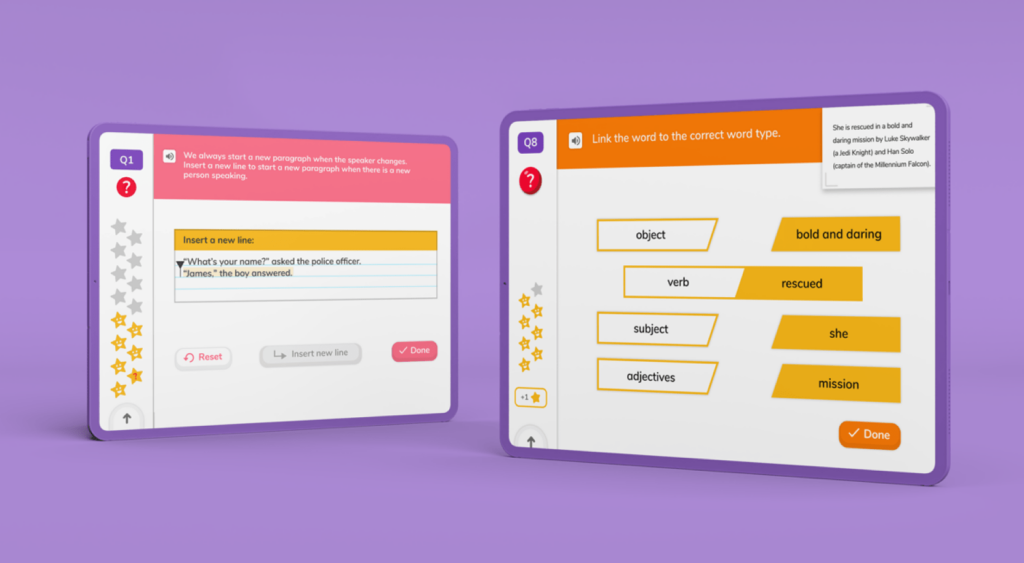

During my time as a primary school teacher, I distinctly remember being given weekly spelling lists and thinking of the coming challenge that would be to get my pupils to learn their spellings.

Author
Lucy Hart
Published
August 2024


During my time as a primary school teacher, I distinctly remember being given weekly spelling lists and thinking of the coming challenge that would be to get my pupils to learn their spellings.

Author
Lucy Hart
Published
August 2024


During my time as a primary school teacher, I distinctly remember being given weekly spelling lists and thinking of the coming challenge that would be to get my pupils to learn their spellings.

Author
Lucy Hart
Published
August 2024


Key takeaways
Diverse Learning Strategies: There are various fun and interactive spelling activities for children in KS2, such as “Look, say, cover, write, check,” “Mnemonics,” and “Word Puzzles,” to make learning more enjoyable and effective. These activities engage multiple senses and cater to different learning styles.
Personalized Learning Tools: Tools like DoodleSpell are designed to encourage daily practice and repetition in creative ways, helping children to learn and retain tricky words more effectively. These tools personalize learning experiences with interactive and engaging activities.
Confidence Building: The ultimate goal of these strategies is to boost students’ confidence in their spelling abilities. By making learning fun and less stressful, children are more likely to enjoy the process and feel more confident in the classroom.
Table of contents
Every child is unique – and so is their learning style. A strategy that works for one child may not necessarily work for another!
With this in mind, here are 10 super spelling strategies for KS2 that will not only help your pupils to learn their spellings, but most importantly, to feel confident in the classroom.
Even if you’ve not used this strategy yourself, you’ve probably heard of it! It’s one of the most common methods that schools use to practise spelling because it’s a multi-sensory approach that involves sight, sound and touch.
Research shows that the more senses a child involves in their learning, the better the outcome!
Let’s have a look at how it works.
There are often rules that can help children to learn more challenging spellings, reducing stress when it comes to those tricky words!
For example, a great rule to remember is ‘I before E except after C’.
Hearing the spelling out loud in a sentence can be a useful reminder of how to spell it!
For this technique, a sentence is read out that includes the spelling word; the child has to write down either one specific word or the whole sentence. This is the method used to test spelling knowledge in both the KS1 and KS2 SATs, so it’s well worth using it in the classroom.
Making spelling fun is the best way to learn. Speaking of which, let me introduce you to DoodleSpell!
DoodleSpell is the ultimate personalised learning app that’s revolutionising the way children learn.
Rather than simply teaching children to memorise words, DoodleSpell helps them to understand the meaning of words and teaches fundamental strategies such as chunking, rhyming and patterns, building a solid foundation of understanding for them to develop in school.
What’s more, it’s packed with thousands of interactive, engaging activities and has virtual badges and rewards that can be unlocked, ensuring that spelling practice is always fresh and exciting!
If you don’t believe us, you can try it yourself… for free!
Unlock unlimited English questions
Put your skills to the test with fun exercises + learning games that are proven to boost ability!
DoodleEnglish is an app that’s filled with thousands of fun, interactive exercises covering grammar, punctuation, spelling and more!
Designed by teachers, it creates each child a unique work programme tailored to their needs, boosting their confidence and skills in English. Try it for free today!

Sometimes just keeping it simple is enough!
Read a word out loud to your child and let them write it down. It may not seem like a particularly exciting technique, but it works super well for children who are auditory learners!
There are two ways to go about it:
You could even let your child record themselves saying a word! They can then play the recording back and write the word down.
Mnemonics or ‘memory aids’ are useful for spellings that can’t be sounded out or don’t follow a spelling rule (we sometimes call these ‘tricky words’).
The most common mnemonics are acrostic ones where you make up a sentence for each letter of the word. Here are a few of our favourite examples:
Sometimes the physical act of writing a word down can help children with to learn their spellings. After all, it’s not just your brain that remembers things: muscle memory is just as effective!
Try getting your child to write a word down (in their best handwriting of course) on a piece of paper. Then, using tracing paper, ask them to trace the words they’ve written.
This is a terrific tactic for children who are kinaesthetic learners who learn best when doing something practical.
Sometimes the physical act of writing a word down can help children with to learn their spellings. After all, it’s not just your brain that remembers things: muscle memory is just as effective!
Try getting your child to write a word down (in their best handwriting of course) on a piece of paper. Then, using tracing paper, ask them to trace the words they’ve written.
This is a terrific tactic for children who are kinaesthetic learners who learn best when doing something practical.
If your child is competitive, what better way to get them excited about learning than challenging them to spell against the clock?
It’s as simple as it sounds. Read out a word (or a few!) and get your child to either spell it aloud or write it down. See how fast they can do it! Then, repeat this activity each day to see if they can beat their time!
Who doesn’t love a game? Crosswords, word searches, anagrams and Hangman are all great ways to make learning spellings a little bit different… and a little bit of fun too!
In DoodleSpell, you can add your own spelling lists into the app to transform them into fun sets of exercises. Plus, it’s filled with thousands of interactive exercises that continually adapt to each child’s level, making it the perfect way to liven up their learning and boost their spelling skills!
This is a great activity for the classroom, especially if there are any words that the class are struggling to grasp.
And there we have it: 10 awesome KS2 spelling strategies that are easy to implement and can be used to boost your pupils’ skills in a fun and engaging way!
If you’re looking for more ways to enhance your pupils’ spelling, be sure to give DoodleSpell a try.
Created by our team of teachers, it’s fully aligned to the curriculum and covers all words outlined by the government standards, making it the perfect way to liven up your spelling tests. Give it a go!
Book a chat with our team
If you’d like to use Doodle’s browser version, please visit this page on a desktop.
To log in to Doodle on this device, you can do so through our apps. You can find out how to download them here: